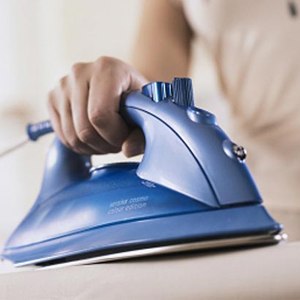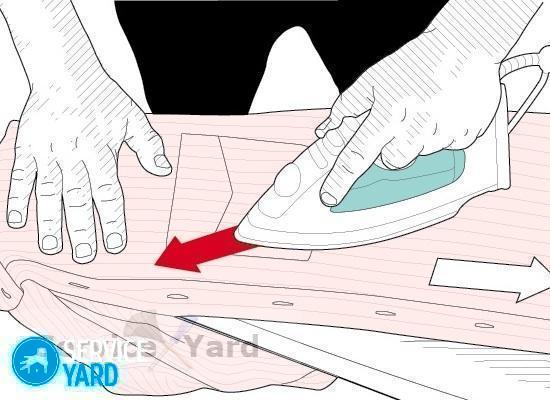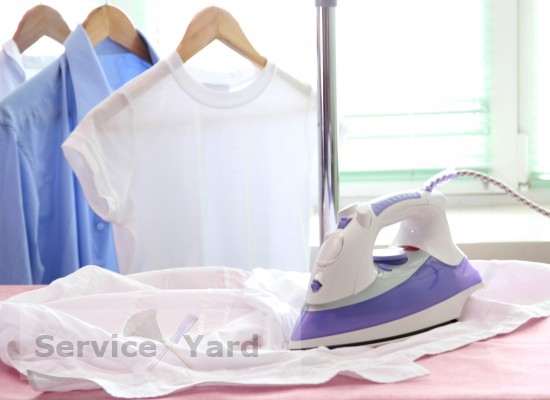How to iron things?

In our age of technology, ironing has become much easier. Manufacturers produce multifunctional irons, which allow us to save not only time and effort, but also not to spoil clothes with thoughtless ironing. Every housewife should know how to iron things correctly in order to extend their life and not even to wear new clothes to return their pristine decent appearance.
to contents ↑Ironing Methods
There are 3 main ways to iron things correctly:
- Dry - is made without moisture from the inside or the front side. In this way, capron and nylon are ironed.
- With hydration. The products to be smoothed are slightly sprayed with water or rolled up in a damp towel for even moistening and ironed with a hot iron.
- With steaming. This method is applied using a damp cloth and a regular iron. If possible, you can resort to using a special iron with a steaming function. This method cannot be used when leveling things that shrink, for example, viscose fabrics.
to contents ↑Important! In each case, choose the method of ironing experimentally, but first experiment on a piece of fabric or from the inside.
How to iron different types of fabrics?
 Before ironing clothes or items of any type, carefully consider the tag for things and find out the necessary temperature regime, which depends on the composition of the fabric. Products from various materials require their processing:
Before ironing clothes or items of any type, carefully consider the tag for things and find out the necessary temperature regime, which depends on the composition of the fabric. Products from various materials require their processing:
- Lining (satin, twill, silk) does not withstand wet processing, as they lose their luster and water stains form on the fabric. Lining fabrics are ironed from the wrong side.
- Try to iron synthetic fabrics as little as possible. Use only a warm iron when working. Synthetic fabrics do not completely moisten, use wet rags for individual areas, iron synthetic material through the lining fabric.
- Iron the jersey only as a last resort using a damp cloth and a warm iron. The material is stretched, so during operation, move the iron so that the product does not deform. Iron products with embossed patterns through linen fabric, without pressure.
- Silk fabrics - iron slightly damp. If they are dry, wrap the material in a wet cloth for 30 minutes, and then iron it. It is impossible to spray the product from silk, as drops of water can leave spots that will appear later. Iron the silk from the wrong side through a thin cloth. Silk of light tones leaves an exception - it is better to iron them on the front side.
- Raw silk is used for sewing mainly curtain and decorative products. It is imperative to iron such material in the wet state from the inside through the canvas with a very hot iron.
- Rayon. After washing, do not hang artificial silk items on the rope, but wrap them in a dry towel or sheet that absorbs moisture well. Iron the product from the inside with a moderately heated iron.
- Products made of nylon cannot be ironed, so after washing, hold the product under running water from the shower so that all folds are smoothed.
- Viscose fabrics should only be dry.
- Iron the chintz on the front side, this will give it a glossy shine. When ironed from the inside, the chintz will get a matte tone. Moisten a dry cloth. If you want to stiffen the product, then wet the item in water with gelatin (1 tbsp.l gelatin per 1 liter of water). After the procedure, do not unscrew the product, but dry it by wrapping it in a cloth, and while the item is wet, iron it with a hot iron. After this treatment, the dress will look more elegant, since rigidity will emphasize the details of the style.
- Terry products: towels, sheets, bathrobes are not recommended to be ironed, as they lose their qualities during ironing, become stiff and do not absorb moisture well.
- To properly iron things from velvet and plush, run the iron only on the wrong side of the material. Attach one end of the fabric or product to the table, and pull the other slightly with your left hand. Moisten the inside out and quickly swipe it with a hot iron. Smooth wrinkled, dented areas of velvet or plush, keeping the product nap down over dishes with boiling water.
- Knitwear Things made from knitwear require special attention, because if improperly processed, they easily lose their shape. Iron them slightly damp from the inside using a damp cloth. Apply iron sequentially to new areas without moving around things. Leave the ironed thing to cool, laid out on the table.
to contents ↑Important! Before ironing things, be sure to determine the composition of the fabric by the tag on the product, since:
- linen cloth is ironed at a temperature of 190-230 C;
- cotton products - 165-190 C;
- natural silk - 115-140 C;
- viscose 85-115 C.
How to iron clothes?
There are several rules on how to iron things correctly, which will help you greatly facilitate the whole process:
- Position the ironing board so that light falls on the left side and the cord does not interfere with the process.
- If there is no ironing board, then use the table, covering it with a blanket.
- You need to iron from right to left, starting from the widest part of the clothes in the direction of the narrow.
- Drive the iron along a straight thread along and along a straight fabric, otherwise you will stretch it unevenly.
- When ironing, the fabric cannot be pulled.
- Lay out the thing evenly, as it should look ready-made.
- First, iron the small parts (collars, sleeves, pockets, cuffs, lace, embroideries), and then the rest of the product.
- Always wear dark fabric clothing from the inside out.
- When leveling an unfinished product, remove the marked line, threads, pins that may be printed on the product from it. Iron the unfinished product at each stage of manufacture, as well as after completing all work.
How to iron trousers?
Ironing things like trousers all the time causes certain apprehensions among the housewives: to make arrows or not, how to even out the places near the pockets and many more unanswered questions can cause the damaged thing. That is why it is better to familiarize yourself in advance with what and how to do it, and act on the recommended algorithm. Then ironing things will be much easier.
After washing, the trousers must be smoothed:
- Start from the inside out. Iron all seams, lining and pockets.
- Turn the trousers to the front side.
- Prepare the cheesecloth, moisten it and spread it on those areas of the product that you will iron.
- Iron the top and waist.
- Fold the trousers so that the side and interior seams match.
- First iron the inside of the legs, and then the outside, smoothing the folds well.
- If the trousers are stretched out on your knees, then moisten this place from the inside with water, and then, turning it on the front side.
- Place a dry cloth between the damp cloth and trousers and iron.
- After processing, hang the pants on a hanger and let them cool.
Important! Smoothed folds will retain their appearance much longer if the fabric from the inside is moistened with a starch solution. Remove starch from the iron with salt.
To keep the arrows for a longer period, they must be rubbed with soap from the inside and ironed through gauze slightly moistened with vinegar.
How to iron a shirt?
For ironing to be as effective as possible, the shirt should be a little damp and the iron well warmed.Start ironing with the collar, carefully straightening it and ironing it, first from the inside, then from the outside. Lead the iron from the corners to the middle. Iron the shirt on the front side in this order:
- Collar (on both sides).
- Back.
- If there is, coquette.
- Sleeves.
- Before.
Important! When ironing the cuffs, be sure to fasten them and straighten them on the ironing board. It is necessary to iron cuffs from two parties. You can use a special small board to iron the sleeves, this will simplify your work.
Dresses and skirts
- The skirt or dress is first ironed top: neckline, collar, shoulders, and then the hem.
- At the beginning, iron across and then along the product, simultaneously straightening the formed folds with the tip of the iron.
- Iron the vertical grooves to the middle, and the chest grooves down.
- To prevent tucks and seams from being printed on the fabric when processing the dress, first iron the entire dress, and then, bringing the iron under the allowance, carefully smooth out the remaining marks.
- If the product is made of thick fabric, then iron the hem carefully, without pulling the fabric, slightly steaming the place of the hem.
Important! Before washing skirts and dresses with pleats and pleats, knit the edges of all folds with large loose stitches, dry the clothes on a hanger, carefully straightening them and stretching the folds. With this preparation, ironing the folds will not be difficult.
Classic costumes
 Correctly stroking a suit is a science. But if you keep some secrets, you will 100% cope with this task:
Correctly stroking a suit is a science. But if you keep some secrets, you will 100% cope with this task:
- Iron suits through wet gauze so that the fabric does not shine.
- Jackets and cardigans start ironing from the sleeves: iron the lining first, using an extra small board.
- Then - round, from side to side, iron the top of the jacket and floors, after which, iron the collar, back and lining.
- Lastly iron the sides.
- Iron trousers more often than a jacket. With daily wear, the front arrow line is quickly lost.
- Ties ironing is not recommended. To freshen up and straighten them, wrap a liter jar of hot water with a loose tie.
Important! The jacket can not be ironed. You can simply hang it over a bowl of steam and leave it so that it hangs.
Little tricks and useful tips
- Hold a dress that cannot be ironed with a hot iron over a basin of hot water. After the product has been steamed, hang it on the hangers to dry. Then do not iron with a hot iron.
- The tanning of the iron on silk fabric can be removed with gruel from drinking soda and water: wipe the stain with a product, and after drying it, clean the soda with a brush. Rinse the entire product in cold water.
- The arrow on the trousers will last longer if you iron the trousers through a cloth moistened with a weak solution of vinegar, and then, when the trousers become dry, again process them with an iron through moist, dense paper.
- Do not hang ironed items immediately in the closet, but let them hang and cool so that they keep their shape longer.
- Do not iron clothes with stains, otherwise such dirt will be very difficult to remove.
- To make the pockets and edges of the product more collected and tight, iron them with a compact: smooth the edges, cover with a slightly damp cloth and place an iron on them for 2-3 seconds. Then - cover with a dry rag and press until completely dry.
- If the seam needs to be pulled out, cover it with a damp cloth. Gently pull and straighten with your left hand, and iron the seam with your right hand. If it is necessary to reduce the elongated seam, iron it with high temperature through a moistened cloth, pressing the iron from time to time, allowing the steam to soak the entire fabric. Continue the procedure until the fabric is completely dry.
- If you burned the fabric while ironing, soak the stain with a solution of boric acid, and then wash the product in room temperature water.
- Burned spots can be removed with onions: cut the head of the vegetable and rub the stain.After processing, wash the material with a detergent solution.
How to iron clothes?
Volumetric sets for sleep, which need to be leveled after washing, for some cause a strong desire to postpone this procedure, because you will have to spend a lot of time and effort. But, if you know how to iron clothes correctly, you will be surprised how simple and quick it is to complete all household chores and put things in order for the bed.
We offer some of the simplest tips to help you ease your work and make it effective:
- Cotton sheets should be moistened by spraying them with hot water, since overwhelmed linens will absorb worse than cold water.
- Roll wet laundry and let it rest for some time to moisturize it evenly, and then proceed with the ironing process.
- To return the items to their original washing condition, align them by pulling the ends.
- Large things: duvet covers, tablecloths, sheets fold four times and iron each part separately.
- Iron linens on the front side, and areas with embroidery on the inside.
- When ironing towels, napkins, handkerchiefs, tablecloths, start processing from the edge, and then smooth the middle.
How to iron things for newborns?
For our grandmothers, ironing children's things was mandatory, since such processing helps protect the baby from bacteria. In the modern world, each mother solves this issue for herself, depending on her beliefs. But in favor of the fact that ironing things for newborns is necessary, says the following:
- During the ironing, you can kill all those microbes that got on the clothes of the newborn during drying on the balcony.
- The umbilical wound of the baby is a kind of gateway for infection, so until the wound heals, do not risk it and iron all children's things.
- The skin of a newborn baby is very soft, and ironed things are much softer than those that have not been ironed.
- The seams after ironing will not rub the delicate skin of the newborn, and the diapers will not be so stiff.
- It is necessary to wash and iron new, newly purchased things, as only such processing will remove all factory and warehouse contaminants.
- Ironed items look much tidier than laundered, but not ironed items.
Important! Is it worth it to iron things from two sides, many ask. Our mothers and grandmothers always insist on this method, because they consider the bilateral ironing method to be the most correct. In fact, it’s enough to iron things for children only from the side on which they are adjacent to the baby’s body.
So do not add unnecessary worries to yourself - how to iron things for newborns, read our recommendations below:
- Before starting ironing, be sure to sort the clothes by type of fabric and temperature.
- Start the ironing process with things with the smallest temperature and go gradually to things with a higher ironing temperature. So you do not have to spend time adjusting the temperature of the iron. You can use the same technique when ironing adult things.
- Since all things and diapers are sewn from cotton, soak them with warm water from a spray bottle before ironing or use a steam iron during processing - so the laundry will smooth out faster and the bacteria will all die.
- When ironing, use the special mode on the iron for cotton.
- Carefully iron things from the side that touches the baby’s skin. At first it is better to iron diapers on both sides. So the child will be more comfortable and safe.
- After ironing, be sure to let the little things lie down and cool down, then fold and put them in the closet. If you fold the hot clothes, then folds, creases will form on it and an unpleasant smell will appear.
to contents ↑Important! So that during the ironing of children's things you do not get tired of either your arms or your back, choose a convenient, height-adjustable board. Get a good steam iron.This will reduce ironing time by at least 3 times.
Stock footage
We hope that thanks to our tips and tricks, ironing for you will turn into a fascinating and pleasant procedure. In the end, working with an iron can be combined with watching an interesting movie or listening to music. Then the time behind the ironing board will pass unnoticed.
- How to choose a vacuum cleaner taking into account the characteristics of the house and coatings?
- What to look for when choosing a water delivery
- How to quickly create comfort at home - tips for housewives
- How to choose the perfect TV - useful tips
- What to look for when choosing blinds
- What should be running shoes?
- What useful things can you buy in a hardware store
- Iphone 11 pro max review
- Than iPhone is better than Android smartphones



